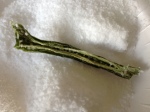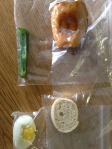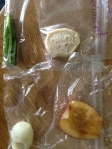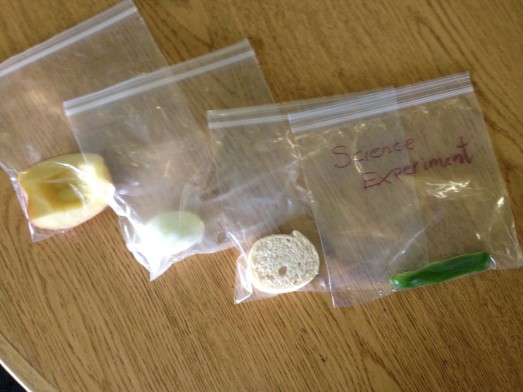How can we keep people healthier by what they eat?
We can preserve food so it can be healthy to eat when you are ready to eat it. You should never eat spoiled food.
What is food preservation?
Food preservation is a process used to slow the spoilage of food. Food spoils because of pests and microorganisms getting to the food. Microorganisms multiply in the food and diseased pests getting at the food will cause food to go bad. Food preservation prevents pests and microorganisms from spoiling food.
Without good preservation, food could not be transported far and famines would happen more often around the world. Food poisoning would also happen more frequently without proper food preservation.
Food Preservation Chart
| What is the food preservation method? | What foods are ideally suited to this preservation method | How is food preserved using this method? | Why is this method a good idea to use? |
| Canning | Soup, fruits, vegetables, beans, fish, meat, and poultry are ideally suited for this method. | Food is placed in an airtight container and is heated to destroy microorganisms. | Canning has been proved to be a successful way of packaging food for long term storage. |
| Pickling | Cucumbers, vegetables, fruit, meat, eggs, and nuts are the foods that are ideally suited to this preservation method. | To pickle foods, add vinegar, salt brine, or sometimes sugar. | This method is a good idea to use because it adds flavor while preserving the food. The salt and acid help kill microorganism. |
| Freezing | Vegetables, meat, fish, poultry, and juices are all items you can freeze. | Put the food temperature below 0F if you want to freeze. | Freezing slows the growth of microorganisms. |
| Curing | Curing is used mostly on ham, pork, corned beef, fish, potatoes, and cucumbers. | To cure, add salt or spices. | Lots of salt helps kill microorganism and flavor foods. |
| Drying | Foods that can be dried include raisins, tomatoes, peas, soups, milk, eggs, and mushrooms. | Drying works by heating to take away the moisture so it’s harder for microorganisms to grow. | Microorganisms cannot survive without water. |
| Cold Storage or Refrigeration | Dairy, vegetables, fruit, meat, and fish should be refrigerated. | Keep the food near, but above freezing. | Cool temperatures slow the growth of microorganisms. |
Interview Transcript with the Remsenburg-Speonk School Cook Manager
How do you store the school’s food safely?
Frozen foods stored below 0F and refrigerated food stored below 40F to keep it safe
How do you prepare the food to keep it safe?
Certain food is cooked to certain temperatures
How do you learn about about keeping food safe?
Took a class at Board of Health; learned about food, gloves, etc.
Is there anything else you could tell us about preventing food poisoning?
Cook food to the right temperature
Is there anything else you could tell us about safe food storage methods?
Every morning check temperatures
Original Research Part II:
Which Preservation Method Works Best?
Learning Goal: The goal is to find out which food preservation method works better to preserve food.
Problem Statement or Testable Question: Which preservation method preserves the longest?
Hypothesis: Freezing will make the food last longest. The control group will be the least successfully preserved.
Materials
- 4 hardboiled eggs (dairy/protein)
- 4 slices of bread (grain)
- 4 pepper (vegetable)
- 4 pieces of apple (fruit)
- salt
- refrigerator
- freezer
- clear plastic zipper bags
Procedure:
- Salt cure one egg, slice of bread, pepper slice, piece of apple
- Refrigerate one egg, slice of bread, pepper slice, piece of apple, each in a separate plastic bag.
- Freeze one egg, slice of bread, pepper slice, piece of apple, each in a separate plastic bag.
- Control Group: Leave one egg, slice of bread, pepper slice, piece of apple, each in a separate plastic bag.
- Check regularly and record data
Observations/Results:
At the start of the experiment, all of the food started fresh.
The school was closed during the second week and we did not make an observation.
By the third week, the control group that did not receive a treatment was starting to spoil. The apple and egg started to get brown. The food in the salt started to dry out. Food in the refrigerator and freezer did not seem to change.
| Bread Control Group  |
Egg Control Group  |
Pepper Control Group  |
Apple Control Group  |
| Bread Salt-Cure  |
Egg Salt Cure  |
Pepper Salt Cure  |
Apple Salt Cure  |
By the fourth and final week, all the control group was covered in mold. All the foods in the salt group were hard and desiccated, but had no signs of spoiling. The apple, pepper, and egg in the refrigerator looked the same, but started to get mushy and the bread was very hard. The food in the freezer stayed the same.
Control Group |
Salt Cure |
Refrigeration |
Freezer |
Conclusion:
Both the freezer and salt cure preserved the food for the longest. The food in the freezer looked nearly the same as when we started. The food in the salt was preserved, but all of the water was removed and the idea of salty food doesn’t sound like it tastes good. The refrigerator preserved the food longer than the food left out on the counter.

